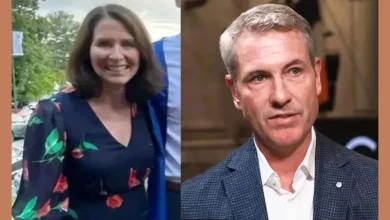The Heartbreaking Call That Shook a Nation
On a somber night in March 2005, the world was introduced to the quiet bravery of a little girl named Tia Hernlen. The tragedy that unfolded in her Florida home was as haunting as it was heartbreaking. Tia, just five years old at the time, became the voice of sorrow and innocence when she made a chilling 911 call after discovering her parents had been shot. That call, filled with confusion, fear, and innocence, resonated deeply with millions who would later hear it played on news stations around the globe.
The incident took place in Volusia County, Florida, and quickly captured the attention of the media, law enforcement, and the general public. Tia’s composed yet heartbreaking voice during the emergency call revealed a maturity and strength far beyond her years. Despite being in an unimaginable situation, she remained calm enough to provide essential information Tia Hernlen to the 911 operator, ultimately ensuring she would be rescued and protected in the hours that followed. But behind her composure was a little girl whose world had just been shattered.
The Tragic Death of Her Parents
The events leading up to the fatal shooting of Tia’s parents, Julie Hernlen and her husband, John, revealed a grim reality about the cracks in the legal system. The Hernlens had previously reported threats made by a man named David Edward Johnson, who had a prior criminal record. They feared for their safety and sought help through legal channels, believing that the system would protect them.
Despite their efforts, Johnson was not stopped. On the night of the tragedy, he entered the Hernlens’ home and fatally shot both John and Julie while they slept. John died at the scene while Julie, although gravely wounded, survived long enough for her daughter to find her and make that fateful call. Not long after the attack, Johnson turned the gun on himself, committing suicide. This shocking conclusion left the public in disbelief, wondering how such a preventable tragedy could unfold in such a brutal way.
The 911 Call That Captured National Attention
The emotional weight of Tia Hernlen’s 911 call left an indelible mark on the hearts of all who heard it. Her small voice, steady yet laced with fear, conveyed a situation no child should ever have to face. She informed the dispatcher that her parents had fallen and were bleeding, that she thought they had been hurt while sleeping. Her innocent interpretation of the scene was both a testament to her young age and a chilling reminder of the horrors she had just witnessed.
What stood out in the call was Tia’s calm demeanor and articulate communication. She described how she had fed her pets, dressed herself, and waited for help—all before sunrise. This incredible composure drew admiration and sorrow in equal measure. Many listeners found themselves overwhelmed by the raw pain in her voice, combined with her remarkable bravery.
The call also underscored the critical importance of emergency response systems and how they rely on even the youngest of citizens in times of crisis. The dispatcher’s guidance and support played a key role in making Tia feel safe and cared for during those terrifying moments. The call became one of the most widely circulated 911 recordings, often used in training sessions for emergency responders.
Public Reaction and Media Coverage
As news of the tragedy spread, the media swarmed the story. Newspapers, television stations, and online news platforms covered the incident extensively. Tia Hernlen quickly became a symbol of tragic innocence and strength. Public reactions ranged from profound sorrow to anger toward the perceived failure of the justice system that had not acted swiftly enough on the Hernlens’ concerns.
Some media outlets chose to focus on the broader implications of the case—highlighting issues such as domestic violence, legal restraining orders, and how the justice system handles threats and prior offenders. Advocacy groups used the tragedy to urge reforms in how protective measures are enforced and how authorities assess threats to families.
Amid the media frenzy, many questioned the ethics of broadcasting the actual 911 call, arguing that it invaded the child’s privacy and compounded her trauma. Others defended the decision, saying it served to highlight the gravity of the situation and the courage of a child caught in a nightmare.
The Aftermath and Legal Implications
Following the incident, intense scrutiny was directed toward the local legal and judicial system. Investigations revealed that David Edward Johnson had indeed been under scrutiny for threatening behavior, and that the Hernlens had tried to take legal action against him. Unfortunately, bureaucratic delays and insufficient evidence had slowed the process. By the time Johnson acted on his threats, it was too late.
In the wake of this tragedy, officials promised reforms. Changes in how restraining orders were processed and how high-risk individuals were monitored were proposed in various jurisdictions. Lawmakers pointed to the Hernlen case as a tragic example of why timely intervention is essential when individuals report credible threats to their safety.
Though the system failed the Hernlens, their story served as a powerful catalyst for change. While not every proposed reform was enacted, the public conversation shifted significantly regarding the protection of families from known threats. Tia Hernlen’s story was no longer just about one family; it became a symbol for the countless others who faced similar dangers.
The Future of Tia Hernlen
Following the murder of her parents, Tia Hernlen was placed into the care of extended family members. Authorities and the courts moved quickly to ensure she would be placed in a safe, nurturing environment away from the public eye. For a time, news outlets attempted to follow her story, but her family sought—and was granted—privacy to help her heal from the trauma.
As years passed, Tia faded from the spotlight. Little was made public about her upbringing or how she coped with the tragedy. This silence was a sign of respect from the community and media alike, acknowledging that she deserved a life free from the burdens of public attention and constant reminders of her past.
Many psychologists and child welfare experts weighed in on how a child like Tia might recover from such a traumatic experience. They emphasized the importance of stable guardianship, ongoing therapy, and community support. Though no child ever forgets such trauma, with the right environment and care, many find ways to cope and eventually thrive.
Tia’s silence in the media is perhaps a quiet testament to that healing. Whether she chose to remain out of the public eye or return later in life to speak her truth, she has been given the dignity and space to grow as her own person—not just as a symbol of a national tragedy.
A Symbol of Innocent Resilience
Tia Hernlen’s story is one of profound sorrow, but also of immense courage and quiet strength. In the darkest moment of her young life, she acted with clarity and maturity that stunned even seasoned emergency professionals. Her 911 call remains a somber reminder of the vulnerability of children and the failures of the systems designed to protect them.
But her story is not just a cautionary tale. It is also a testament to the power of the human spirit, even in its youngest form. Tia showed the world that even in the face of horror, hope, courage, and resilience are possible. Her life became a mirror reflecting both the best and worst aspects of society—our ability to feel compassion and our tendency to act too late.
In years to come, many will continue to remember her—not for the tragedy she endured, but for the way she stood tall amid chaos. The name “Tia Hernlen” is etched into the collective memory of a generation, not just as a victim, but as a brave little girl who did everything she could to survive a moment no child should ever face.
The Enduring Legacy of a Child’s Voice
There are few events that so completely capture a nation’s attention as the story of Tia Hernlen did. In a world often overwhelmed by news cycles filled with statistics and headlines, her story brought a personal and deeply human touch. It forced people to pause and reflect—not just on her tragic circumstances, but on how easily they could unfold again for someone else.
Her legacy is not found in policy alone or even in the haunting echoes of her 911 call. It is found in every parent who now takes legal threats more seriously, in every lawmaker who works harder to improve protective legislation, and in every emergency dispatcher who listens a little more closely to the voice of a scared child on the other end of the line.
Tia Hernlen’s story is painful, unforgettable, and above all, human. It remains a powerful call to action—for empathy, for reform, and for the recognition that even the smallest voice can speak volumes.
FAQs
Who is Tia Hernlen?
Tia Hernlen is a young girl from Florida who gained national attention in 2005 after making a 911 call upon discovering her parents had been shot by a man who later killed himself.
What happened to Tia Hernlen’s parents?
Her parents, Julie and John Hernlen, were fatally shot in their home by David Edward Johnson. John died instantly, while Julie later succumbed to her injuries.
Why was the 911 call so widely shared?
The call was emotionally powerful, revealing the calm and composed voice of a child in distress. It served as a reminder of the vulnerability of children and the importance of timely emergency responses.
What legal actions followed the incident?
The case triggered national discussions on the Tia Hernlen enforcement of restraining orders and the need for stronger protective laws for families facing threats.
What happened to Tia afterward?
She was placed in the care of extended family and kept out of the public eye to allow her to recover and grow in privacy.




